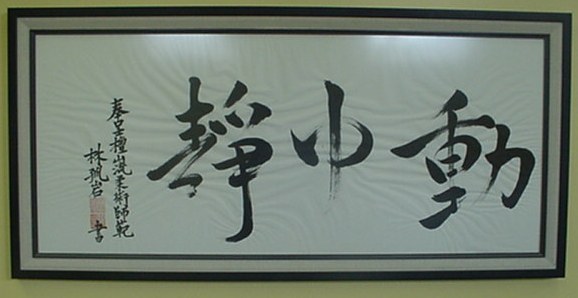It took me several months to train myself to point the toes, plantar flexion, when I lift me knee for a kick. I had to unlearn what Prof. Tom Ryan showed me, lift the toes first for a faster lift. Tonight Kyoshi reminded me that in Naihanchi Kata we lift the toe and then scrap the foot on the ground as it is pulled in and away from Uki's sweep.
Tuesday, July 8, 2008
Green Belt 2nd stripe
Tuesday, June 24, 2008
Slide the post foot to close distance.
Kioshi Dave Joslin talked about sliding the down foot toward uki when doing a kick. After sending a few standard kicks, with the post foot fixed to the ground, mix in a sliding kick. This disrupts uki's maia.
You don't want to skip or hop forward. Just unweight the down foot so that your forward momentum causes the foot to slip a few inches forward. Keep the post foot on the ground, NO weight on the heal, knees bent with the ball of the foot taking the weight and pivoting so the the heal comes forward of the ball during the slide.
Just adding four or six inches to your kicking range will kuzushi uki. You must train this technique so that it become effortless and natural. If they see it coming they will see it coming.
Friday, May 23, 2008
Naihanchi Kata Research
The Tallahassee Karate Club blog has a very interesting article on Naihanchi Shodan. The video clip of Shinzato Sensei doing Naihanchi Shodan is unreal. Granted this is not the exact same kata but it is the same. Can you say fa jing?
Quoting the blog.
Naihanchi is a deep kata that teaches the student most of the principles they will need to be able to apply in all their other kata. By tucking the koshi and feeling the connection between the waist and the lats, the student can begin to learn to make power without relying on the turning motion inherent in other kata....
We often practice Naihanchi very slowly, combined with circular hip and arm motions. To the outsider, this may look a little like Tai Chi and not karate. Practicing this way helps the student to analyze each movement in a critical way to understand where the power points occur, how to make a connection between the bottom half and the top half of their body, and how to improve their overall body dynamic. Then, when it is performed fast, with full power, the student can retain this wisdom in their performance and make power in all the right places.
Sensei Don Bohan has a very informative page on Naihanchi Kata.
There is a Ryuku Kempo site with a QuickTime video of Naihanchi Shoda. Compare this hard toughguy style to the spiral energy of Shinzato Sensei above. Shinzato Sensei is something special!
First Year in Karate

Ms. Bloom and are climbing the ranks together. She is a shining example of someone following the principle taught at Joslin's East/West Karate.
I was just getting use to the physical conditioning (push-ups and sit-ups) when we go and get promoted out of the beginner class. There is a 50% increase in the number of conditioning exercises in the advanced classes. Ouh, ouh, ouh being it on!
Friday, May 16, 2008
Naihanchi Kata
The kata has 67 moves, against 4-8 attackers from the front and sides. Naihanchi Kata is easily recognized by the fact that all movements are on the lateral line, staying on a straight track as if against the edge of a cliff or wall. It takes 35 seconds to execute.
Here is an old film (1966) of Master Tatsuo Shimabuku performing the kata, 1966.
Joslin's East West Karate—Naihanchi Kata Facts
What is the nickname for the Naihanchi Stance? Iron Horse Stance
What type of attacker are we defending against? Chinese Martial Artist
What is this kata known for? Lateral movement
What part of the body is being developed? Lower body
In the Naihanchi stance the toes are pointed inward (pigeon-toed), how many degrees? Ten
Traditionally where might you be defending yourself? Rice paddy, foot-bridge or with back against the wall
Seiuchin Kata
The kata has 126 moves, against 6 attackers but contains no kicks. It takes 55 seconds to execute.
The kata begins slowly with power and ibuki breathing from a horse stance. The floor pattern is a Y for the most part. After the intense opening the kata explodes into a full power fast kata.
Here is an old film (1966) of Master Tatsuo Shimabuku performing the kata.
Saturday, May 10, 2008
Test for Gokyu
As a green belt I now attend the intermediate classes with other green belts and the purple belts. The calisthenics are increased by 50% over the beginning classes.

